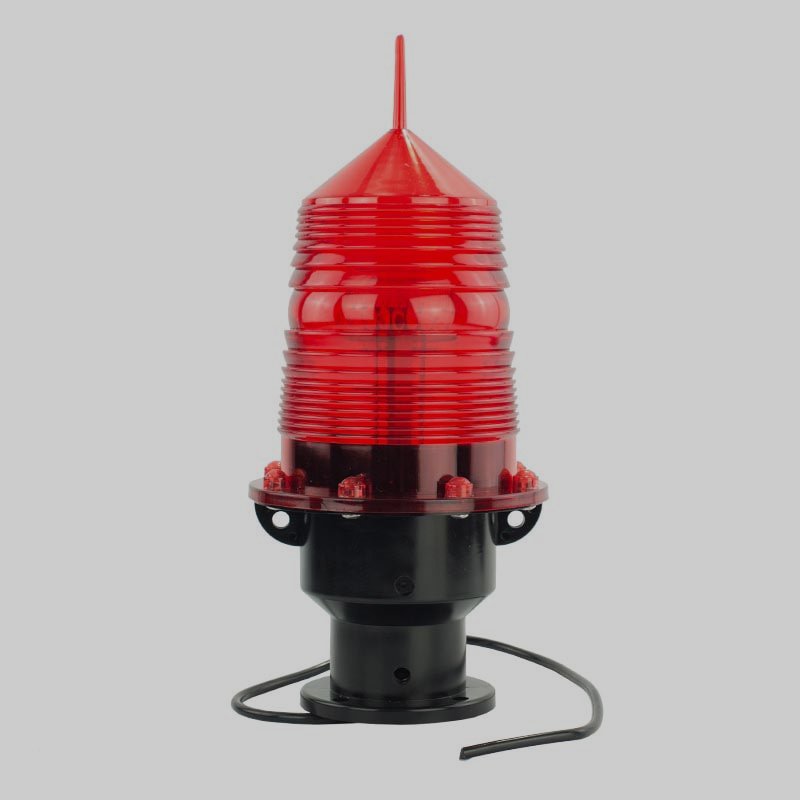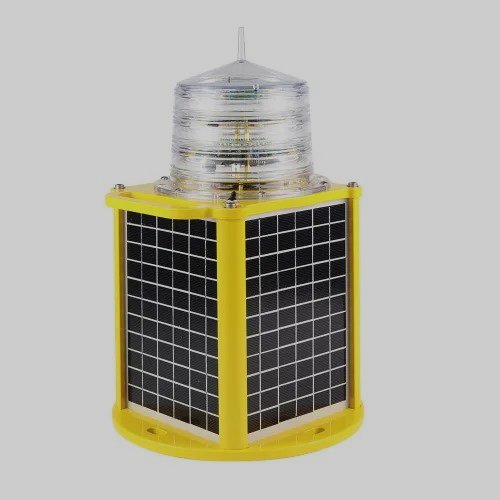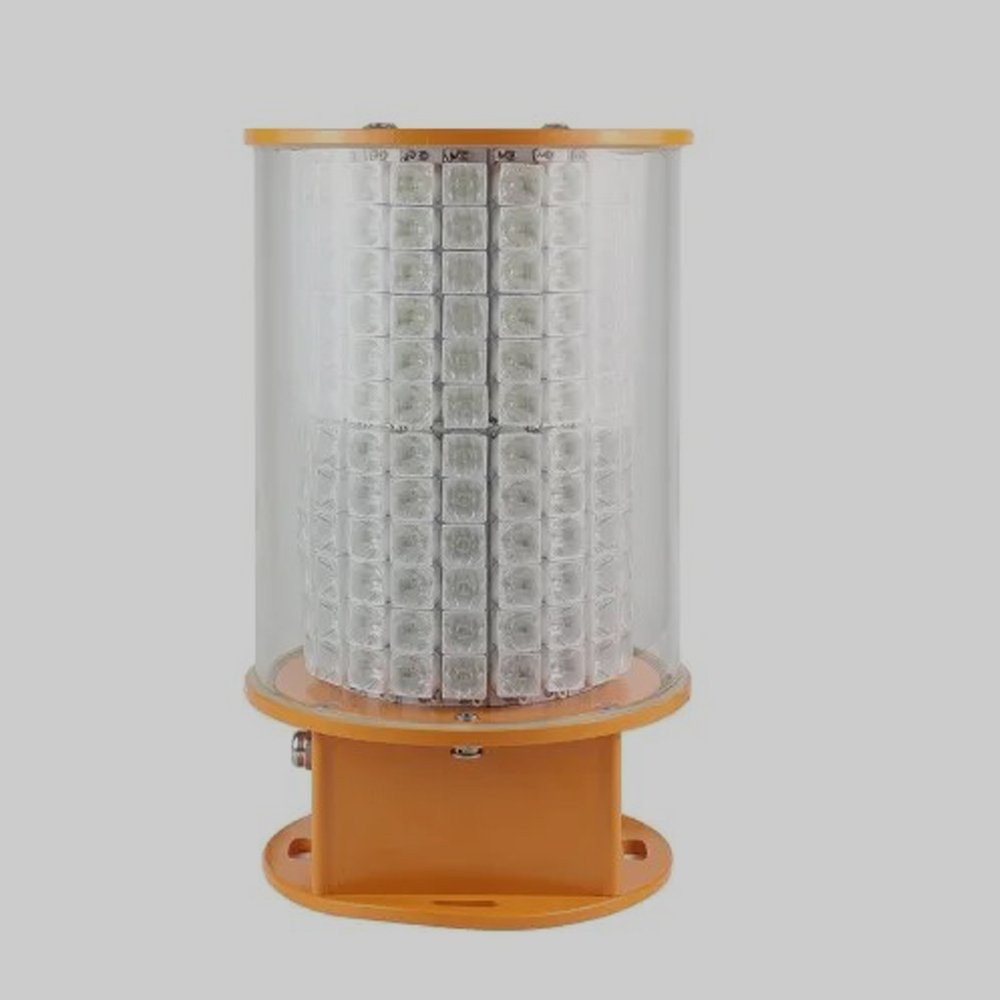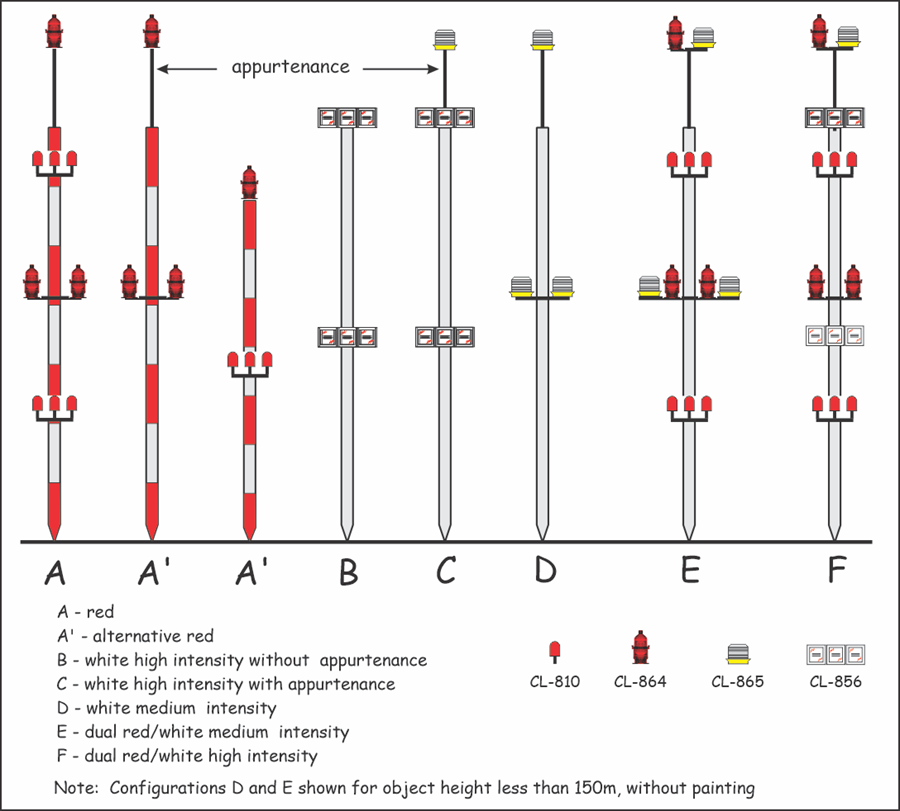In an aviation industry where aircraft safety is non-negotiable, many aviation professionals, warning lights installers, and safety engineers often ask: “how do aircraft warning lights work?” and that’s exactly what this guide discusses.
In this guide, you’ll learn everything there is to know about aircraft warning lights. Like how they work, their importance in aviation safety, their types, and the FAA lighting requirements vary in different structures and locations.
What are Aircraft Warning Lights?
Aircraft warning lights (often known as obstruction lights) are high-intensity lights that are used to enhance the visibility of tall structures. These lights are basically installed on those structures that are tall, located in areas where airplanes operate at low altitude, and can potentially pose a collision hazard while aircraft navigation.
You can generally install them on tall structures such as communication towers, high buildings, chimneys, cranes, fences and airport structures.


The Importance of Aircraft Warning Lights
Imagine you’re a pilot and navigating an aircraft at nighttime or in poor-visibility condition. Suddenly, you spot a tall structure that is barely visible. With a little time available to react, there’s a high chance you could collide with it.
Although one of the FAA aeronautical studies reveals that not marking the tall structure may not impact aviation safety. But in reality, a mid-air collision with a tall structure could probably bring down the structure, leading to loss of human lives, property damage, financial loss, and even legal consequences.
This is exactly where aircraft warning lights play a vital role. These lights provide visual warnings of tall structures to the pilots from a far distance, both during day and nighttime. That way, pilots get alert beforehand and navigate around the structure safely, preventing mid-air accident.
How Do Aircraft Warning Lights Work?
LED Aircraft Warning Lights Working Mechanism Explained
Here’s the breakdown on how aircraft warning lights basically operate:
Warning Lights Activation
After the lights are installed, airplane lights primarily operate and activate using any of the following technologies:
- Lights sensors
- Manual Switch
- Or Aircraft Detection Lighting System (ADLS)
based on how their lighting system is designed.
Aviation warning lights equipped with light sensors system uses photocells which basically detect changes in ambient light and trigger the response accordingly. So when the system detects the change in light, it automatically activates the lights during nighttime or low-light conditions and turn them off during daytime.
Warning lights with manual system, on the other hand, require a human (mostly pilot) to manually activate the warning lights or position/ beacon lights on the aircraft.
Whereas, warning lights with ADLS system are automatic systems that operate based on aircraft movements. So when the system detects that an aircraft is approaching, it immediately turns on the lights. And once the aircraft passes the structure, it turns the lights off.
Flashing or Steady Light Patterns
You’ll often encounter a few tall structures or towers blinking a steady red light while others flashing white light. The reason is that, as per FAA dedicated lighting requirements, based on the structure, structure’s height, and geographic location, aircraft warning lights may light either of the following:
- Steady red light
- Medium-intensity white flashing light
- High-intensity white flashing light
Controlled By a Controller
Many aviation obstructions lights’ systems includes a wireless controller. This controller automates the warning lighting like turning them on/off, adjusting brightness, managing flashing patterns based on the ambient lights and weather conditions. These controllers also send the signal to the concerned departments’ system to alert them about malfunction in the lights.
Use Power Backup
Aircraft warning lights are generally powered up using electricity or solar panels. But they are often connected to external battery backup system or generators. So, during power outages, no sunlight, or bad weather conditions, these lights are powered up using a backup system to ensure continuous operation 24/7.
Different Types of Aircraft Warning Lights
There are mainly three types of FAA aircraft warning lights. Let’s discuss each one:
-
Red Aviation Obstruction (Strobe/ Beacon) Lights
Red obstruction light system are generally used for nighttime visibility. According to FAA advisory circular, you can install red warning lights on shorter structures with height equal or less than 200 feet (60.96 m) AGL. These lights typically lit red flashing or steady-burning light.

-
Medium-intensity White (strobe) Lights
Medium-intensity white light system, on the other hand, are generally used for both day and nighttime visibility. You can install these lights on structures with height between 200–700 feet (60.96-213.36 m) AGL. However, FAA prohibit using medium-intensity lights on structures for nighttime visibility that are located in urban areas.

-
High-intensity White (strobe) Lights
Similar to above, you can use high-intensity white aviation lights to enhance the structure’s visibility during both day and nighttime. However, you can only install these lights on structures with a height above 700 feet (213.36 m). Also, you cannot use high-intensity lights for 24-hour visibility of structures located in urban or high-population areas, as per the FAA.
Information: To mark structures located in urban areas, as per FAA, you can use dual-lighting system. This system is composed of both red and mid-/high-intensity white lights. Red color for nighttime visibility and white for daytime visibility.

Aircraft Warning Light Diagram

Aircraft Warning Lights Regulations – Country Vise
| Country | Aircraft Warning Lights Regulations |
| South Africa | In South Africa, aircraft warning lights are mandatory for tall structures exceeding 45 meters. According to aircraft warning lights South Africa standards, both red (night) and white (day) lights must be used for visibility. |
| Австралия | The aircraft warning lights regulations Australia follow CASA guidelines. Based on CASA Part 139, structures above 110 meters AGL must have appropriate obstruction lights. |
| United Kingdom (UK) | Aircraft warning lights UK states that any building or structure exceeding 150 meters must be lit with high-intensity red lights. The aircraft warning lights regulations UK also require lighting for structures below 150 meters (based on location). |
| Malaysia | Aircraft warning lights regulations Malaysia dictates that any structure above 150 feet (approx. 45 meters) must follow ICAO-based lighting requirements, including medium-intensity red lights and white strobes. |
| United Arab Emirates (UAE) | Aircraft warning lights regulations UAE require lighting for obstacles taller than 45 meters. Structures should also must comply with GCAA CAR Part IX, recommending dual lighting systems. |
| Singapore | The aircraft warning lights regulations Singapore applies to buildings, towers, or cranes over 45 meters AGL. Depending on the environment, medium or high-intensity lights are required for safe air navigation. |
What is an Airplane Beacon Light?
An airplane beacon light (often known as anti-collision light) is a red flashing and often rotatable light that is mounted at the top, bottom and sometimes at the tale of the aircraft. You’ll typically see beacon lights on larger passenger aircraft, not on others.
Pilots actually activate these lights when the aircraft’s engine is starting up, running, turning off or the airplane is just about to move, to alert ground staff and other nearby airplanes.
What are Navigation Lights on Aircraft?
Airplane navigation lights (often known as position lights) are red, green and white color lights that are basically installed on the aircraft’s wing tips and tail. Red on the left and green on the right side of the wing tip, while a white light is installed on the tale.
These lights help other pilots and air traffic personnel identify movements of other aircraft. Like in which direction the aircraft is approaching, moving away, and turning.
Aircraft Warning Lights for Buildings
To install aircraft warning lights on buildings, according to FAA, you need to install medium-intensity red lights (Type L-864) at the most highest top of the building. If the building is extremely tall or located near an airport, you may also need to install medium-intensity white flashing lights (Type L-865) for daytime visibility.
Aircraft Warning Lights on Towers
If the tower height is more than 200 feet, then as per FAA, you will need to install dual-lighting system, especially if the tower is located in the urban area. But if the tower height is less than 200 feet and is located very near the airport, you may still need to mark the tower red for daytime and medium- or high-intensity white light for daytime visibility.
Not sure which aircraft warning lights you should install on your tower? Jackwin has the professional team with extensive knowledge in aviation field. Send us your query today to get personalized help from us.
Tower Crane Aircraft Warning Lights
As per FAA, if the crane height is within 150 feet (45.72 m) AGL or less then you need to install two or more steady-burning or flashing red (L- 810/L-810 F) at the high tip of the crane.
But if the crane height is more than 150 feet (45.72 m) but less than 350 feet (106.68 m) AGL, then you will need to install one red flashing (L-864) at the top and two or more from the mid to top length of the crane.
What is Aircraft Warning Lights Price?
Generally, for small structures like low towers, basic low-intensity lights price start around $100 to $200 per unit. However, for larger structures such as communication towers, tall buildings, or wind turbines, FAA requires installing medium, high-intensity lights or dual lighting systems. Since these lights are more advanced so they range between $800 to $2,000 or more per unit.
For industrial or commercial use, like on airports or tall cranes, you may need to purchase a full lighting systems (including controllers and backup power). So that may cost you around $10,000 to $20,000+, depending on the size of the structure and the number of lights you may need.
If you want to get aviation warning lights at affordable rates, we suggest you deal with a wholesale supplier as they offer products at affordable factory prices.
Best Aircraft Warning Light Suppliers
As the leading aviation obstruction light supplier, Jackwin manufactures and offer a complete range of aircraft warning lights. Whether you need obstruction lights for marking towers, cranes or tall buildings, we have a solution for your every need.
Our aircraft warning lights are solar-powered, extremely bright, waterproof and weather and impact resistance, come with 2-year warranty and are manufactured keeping ФАУ, ФКС и ИКАО regulations in mind.
Not just that, our professional team can even manufacture a customized aviation warning lights’ solution for your needs or situation at wholesale rates. So связаться с нами today to get instant injury in the first place.
Заключение:
Aircraft warning lights are basically safety lights that not just guide pilots about tall structures in its way, also help identify other pilots and aviation crew to track the aircraft movements. However, where their installation is extremely important, incorrect selection of lights can also make the situation even worse. That’s why it’s crucial for aviation facilities to understand about how warning lights operates and their types to make correct decision.
FAQs related to Aircraft Warning Lights
-
What does aviation obstruction light mean?
An aviation obstruction light means a light that highlight the obstructions in an aviation route. This is basically a high-visibility light that is generally installed on tall structures. By consistently or flashing light, they signal pilots of obstructions to ensure the safe airplane navigation in the air.
-
What is the difference between Type A and Type B?
Type A and Type B both come in the low-intensity obstruction lights category, but they serve slightly different purposes. Type A is used for night-only operations. It provides a steady red light with lower intensity. Type B, on the other hand, can be used for both night and twilight visibility as this offer a slightly brighter red light than Type A.
-
Who is the leading manufacturer of aircraft warning lights?
Jackwin is one of the leading manufacturers of aircraft warning lights. We have been offering aviation lighting to facilities since 2008. Our professional team even manufactures a customized lighting system on customer’s demand. If you need more help regarding lights or selection, feel free to contact our team.
-
What are low-intensity warning lights?
Low-intensity warning lights are steady-burning red LED lights that are used on structures with height<45 meters (150 feet) above ground level.
-
What are medium-intensity warning lights?
Medium-intensity warning lights are basically used on structures between 45 and 150 meters tall. These lights come in three types:
- Red (L-864): For nighttime use
- White (L-865): For daytime use
- Dual lights: Red at night, white during the day
You can install these lights on towers, wind turbines, and tall cranes by following FAA lighting regulations.
-
What are high-intensity warning lights?
High-intensity warning lights are basically Type A (white flashing) lights. These light are generally used on very tall structures, over 200 meters (650 feet). They emit very bright white flashes during both day and night. You can install them on skyscrapers, transmission towers, and broadcast masts.


-80x69.png)

